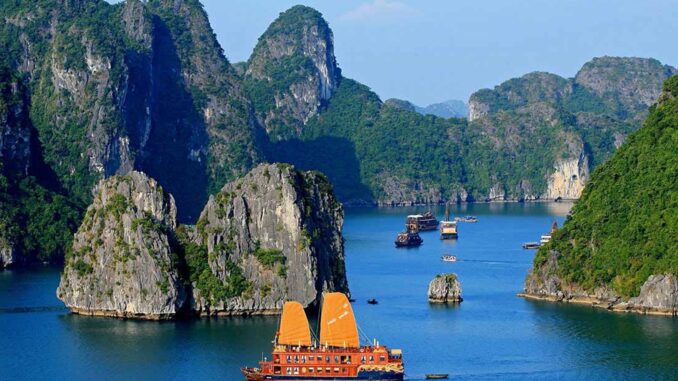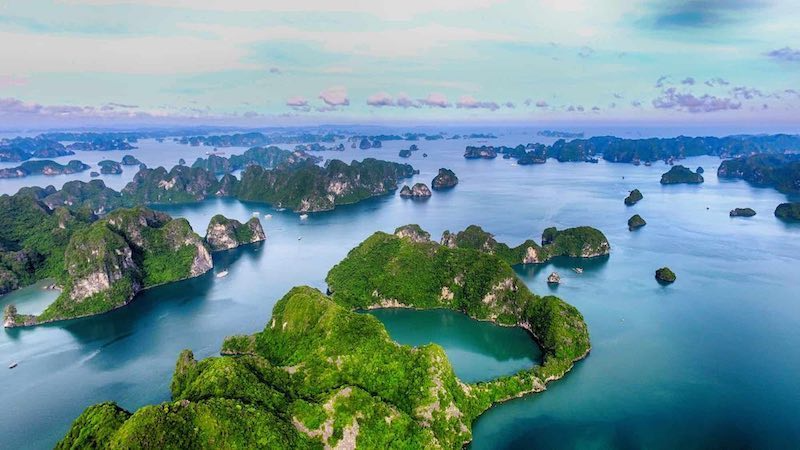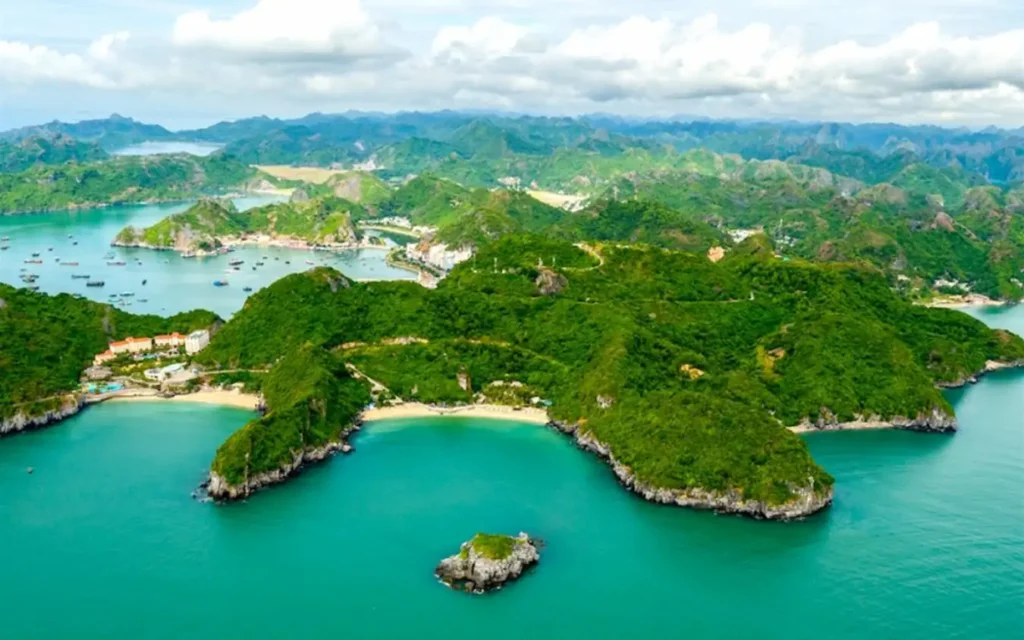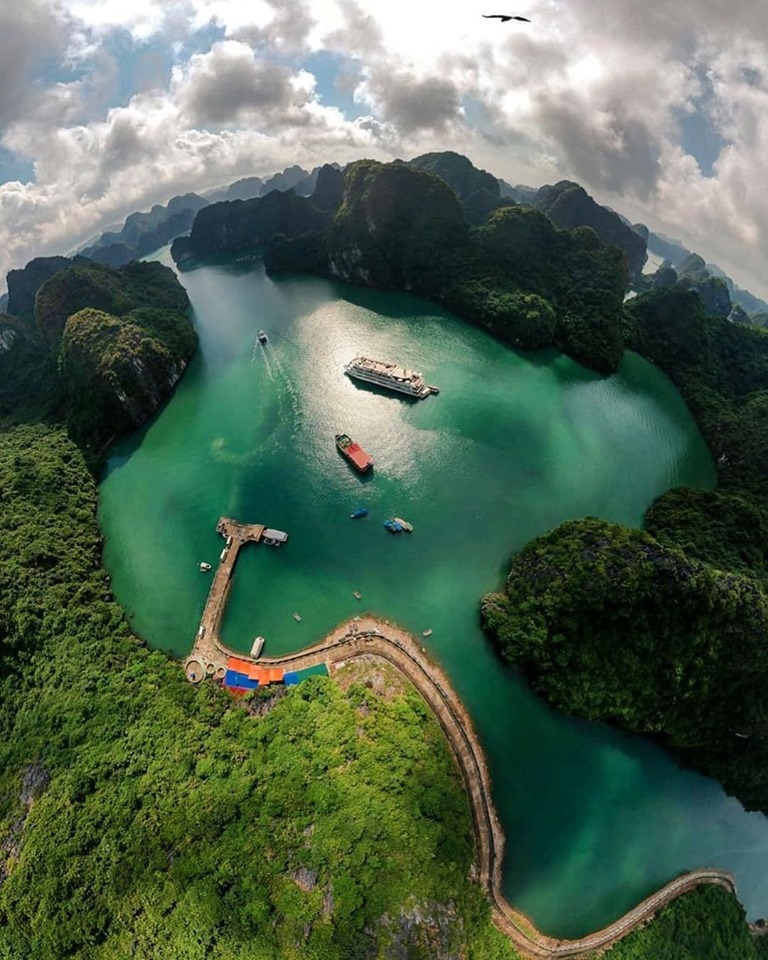
Possessing a vast and peaceful water landscape, Ha Long Bay – Cat Ba Archipelago is created by 1,133 limestone islands of various shapes and sizes on clear, emerald green water. This is also the place that witnessed changes in the Earth’s historical development. The primeval forest is rich and diverse in flora and fauna, with limestone columns covered with rows of deep green tropical trees and a magnificent cave system.
Location
Ha Long Bay – Cat Ba Archipelago is located in the Northeast of Vietnam, a place known as the “pearl of the Gulf of Tonkin”, with majestic mountains, forests, and vast islands. Natural areas have a core area of 65,650 hectares and a buffer area of 34,140 hectares. Ha Long Bay belongs to Quang Ninh Province, and Cat Ba Archipelago belongs to Hai Phong City.
Ha Long Bay
Ha Long Bay features more than 1600 karst limestone pillars and isles in various shapes and sizes, developed in a warm and wet tropical climate. The limestone monolithic islands rise from the ocean, topped with thick jungle vegetation. Several of the islands are hollow, creating enormous caves. Come to Ha Long Bay to admire and enjoy the spaciousness of the endless sea and sky and the magnificence of the rocky mountains and caves here.
The elements of rock, water, forest, and sky combine to create a colorful natural world with irresistible beauty and appeal. The grey of the mountain rocks, the many shades of forest green, the transition between deep sea blue and blue in the lakes, and the hidden pines and fjords of the sea. Even more interesting, the landscape changes color every time it starts to rain, the grey limestone immediately turns dark tones due to the blue-green algae layer on the surface being soaked by water.

Far away in the bay, small, lovely white sand beaches lie under rocky mountains with the immense green color of tropical plants. The elements of rock, water, forest, and sky combine to create a colorful natural world with irresistible beauty and appeal. The grey of the mountain rocks, the many shades of forest green, the transition between deep sea blue and blue in the lakes, and the hidden pines and fjords of the sea. Even more interesting, the landscape changes color every time it starts to rain, the grey limestone immediately turns dark tones due to the blue-green algae layer on the surface being soaked by water. Far away in the bay, small, lovely white sand beaches lie under rocky mountains with the immense green color of tropical plants.
This sea area includes many terrigenous and carbonate sedimentary formations, ranging in age from the Paleozoic to the Neoproterozoic era. Many sedimentary formations in this area contain paleontological traces in the form of different fossils, including groups of animals and plants that are extinct or nearly extinct on Earth. The presence of primeval forests, bays, and islands on the bay is unique evidence of the continuous movement and development of karst landforms, Phong Tung (fengcong) and Phong Linh (fenglin) formations that formed over millions of years under tropical, humid conditions, progressing from high mountain ranges down to the sea, where karst terrain eventually reaches its basic erosion level.
Cat Ba Archipelago

The ecosystem of Ha Long Bay has a high level of diversity, with 7 ecosystems typical of adjacent sea-island, tropical, and subtropical areas developing one after another: Rainforest ecosystem primary tropical; Cave ecosystem; Mangrove ecosystem; Tidal ecosystem; Coral reef ecosystem; Soft bottom ecosystem; Saltwater lake ecosystem.
This place is also the habitat of 4,910 species of plants and animals on land and in the sea, of which 198 are on the IUCN Red List and 51 endemic species. Species are continuing to evolve and form new species here. The ecosystem of Ha Long Bay has a high level of diversity, with 7 ecosystems typical of adjacent sea-island, tropical, and subtropical areas developing one after another: Rainforest ecosystem primary tropical; Cave ecosystem; Mangrove ecosystem; Tidal ecosystem; Coral reef ecosystem; Soft bottom ecosystem; Saltwater lake ecosystem. This place is also the habitat of 4,910 species of plants and animals on land and in the sea, of which 198 are on the IUCN Red List and 51 endemic species. Species are continuing to evolve and form new species here.
Perched on top of the mountain of Cat Ba National Park in the “Ech Pond” area is the appearance of a unique and quite rare type of submerged vegetation. Plants and water species that usually only grow and are distributed in the Southwestern region of Vietnam appear in Cat Ba with almost pure populations. Although the carpet and water have a modest area, they contain an extremely unique gene pool of plant species.
Also in the Cat Ba National Park area, a basin near Viet Hai wharf is largely covered by a freshwater marsh with a mixed canopy. Following the road into the village, forest vegetation gives way to large fields with Phragmites karka (Poac.) reeds. Despite their minor economic importance, each freshwater marsh appears to have different characteristics, many are completely pristine, and some are habitats for unique species. such as Combretocarpus (Family Anaphyllopods). These trees form a layer of intertwined, almost horizontal branches 4m – 6m above the forest floor, from which thick rows of tree roots shoot straight down to the floor. This is a rare phenomenon in freshwater wetlands.
Furthermore, scattered throughout the area are about 119 – 138 saltwater lakes formed from sinkholes, karst funnels, and closed valleys. These lakes, accounting for about 1/3 of the total saltwater lakes in the world, are home to ancient and rare species, are of great value for conservation and scientific research, and are also a favorable environment beneficial for evolutionary species.

Cooperation in heritage conservation
Cat Ba Archipelago becoming a World Heritage Site is also expected to contribute to promoting economic, cultural, and social development, improving the quality of life of Cat Ba people, promoting and enhancing the image of Cat Ba Islands, the country’s position, and attracting ecological and economic investment fields.
The expansion of the World Natural Heritage Ha Long Bay to include the Cat Ba Archipelago will increase the inherent value of the heritage, demonstrated through the harmony of landscape, geology, geomorphology, ecosystem, and diversity of flora and fauna. The region’s outstanding global values are identified as physical and biological formations, geological formations, geography, and habitat for threatened flora and fauna from an aesthetic point of view in aesthetics, science, and conservation.
Conclusion
Ha Long Bay – Cat Ba Archipelago, was registered by UNESCO as a world heritage site in 1994 because it contains areas of natural beauty including limestone islands covered with vegetation and sharp rocky peaks. Limestone rises above the sea surface along with associated karst features such as domes and caves.
The title creates more attraction for the two wonders of Vietnam, opening up many opportunities for tourism development, but it also cannot ignore the challenge of sustainable heritage conservation. Therefore, everyone, including Vietnamese people and tourists, has a duty to work together to protect and maintain the green beauty of this place.
Get an opportunity to visit World Heritage Sites in Vietnam through Vietnam E-Visa!